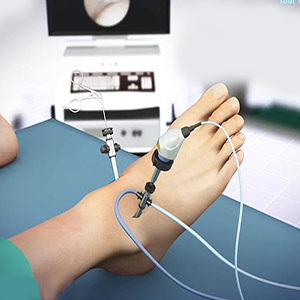Ankle Arthroscopy

This surgery involves looking into your joint with a camera after inflating the joint with saline solution. This allows good visualisation of the joint and also performs therapeutic procedures for ankle joint problems. It is also usually much less painful than a normal open operation and of course the scars are smaller. The risks of infection and other complications are less than open ankle procedures with a quicker recovery time.
Ankle arthroscopy has proven beneficial in multiple ankle pathologies like arthroscopic ankle fusion, microfracture for osteochondral defects, removal of loose body, synovial biopsies and assessment of ligaments.
Surgery is performed under general anesthetic and is a day case procedure.
Two small incisions are made at the front of the ankle to allow the arthroscope and the instruments access to the ankle joint.
Following the procedure, the tissues are stitched, and a wool and crepe bandage is applied.
Risks
All surgery carries potential risks. The risks are minimized by having the surgery meticulously performed by an expert in foot and ankle surgery. Risks include.
- Pain, swelling, and bruising - This can occur after any foot and ankle surgery. You have to keep the limb elevated for 48 hours to avoid swelling .You will be presciped pain killers to help with your pain.
- Nerve damage – This is usually a temporary damage and usually present as numbness on the top of the foot and improves over time.
- Infection – very small risk.
- Blood clots (thrombosis) - treatment to reduce this risk will be provided if required.
- Scar sensitivity - can be improved with scar massage.
- Incomplete improvement and stiffness - occasionally symptoms will be improved but remain present to a small degree. Stiffness will improve with physiotherapy.
Discharge advice following an ankle arthroscopy
Dressings
Your foot has been dressed in a wool and crepe bandage. This should not be changed until you are seen at your first follow-up appointment after 2 weeks. The dressing must be kept clean and dry.
Analgesia
You will receive a prescription for pain medication on discharge. Elevating the limb can help to reduce the pain.
Elevation
You have to keep the limb elevated to reduce the swelling. It will occur to some degree following all foot and ankle surgery. Try not to hang your leg down for two weeks after surgery. The swelling can sometime last for 6 months.
Walking
Most of the times you will be allowed to weight bear as tolerated as guided by the physiotherapists. You might need crutches until your pain and swelling settles down or until the surgeon advises you. You can mobilise the ankle upward and downward to prevent ankle joint getting stiff.
Follow-up
You will be seen approximately 2 weeks following surgery and the dressings and sutures will be removed. Normally you will be able to stop using the crutches by this stage.
Driving and work
You should not drive a manual car for at least 2 weeks following surgery. If you have an automatic car and have only had the left foot operated upon then you may drive after 3-4days.
If you have an office-based job, then it may be possible for you to return after 2 weeks however it is often more advisable to return after 4-6 weeks. If you have a more physical job then it may take 8 weeks.
Recovery
It often takes 3 months for all swelling to resolve and so minor swelling late in the day is not unusual and should not be a cause for concern.
